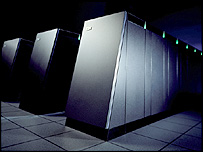onedomino
SCE to AUX
- Sep 14, 2004
- 2,677
- 482
- 98
Now it is almost twice as fast as last year when it became the world's fastest supercomputer. Currently, it is 12,500 times faster than the 1976 Cray 1 supercomputer. At its theoritical peak speed, it will be more than 33,000 times faster than the Cray 1.
Fastest supercomputer gets faster
http://news.bbc.co.uk/1/hi/technology/4379261.stm

Blue Gene snatched the crown from Japan in November
Blue Gene/L, the fastest supercomputer in the world, has broken its own speed record, reaching 135.5 teraflops - a trillion calculations a second.
That is double the speed it clocked up to take it to the number one spot in the Top 500 supercomputer league.
The IBM Blue Gene machine that achieved the new mark is being assembled for the Lawrence Livermore National Laboratory, a US Department of Energy (DOE) lab.
It did 70.72 teraflops last year to beat Japan's NEC Earth Simulator.
The Blue Gene/L is due to be completed for the Livermore labs in 2005.
Its peak theoretical performance is expected to be 360 teraflops, with the machine taking up 64 full racks.
Blue Gene's new record was achieved by doubling the number of current racks to 32. Each rack holds 1,024 processors, yet the chips are the same as those found in high-end computers on the High Street.
The processors are special dual-processing engines, known as cores.
The final machine will help scientists work out the safety, security and reliability requirements for the US's nuclear weapons stockpile, without the need for underground nuclear testing. (what Blue Gene/L will probably be doing at Livermore)
Everyday problems
Supercomputing has been used in the past to work out highly complex scientific problems, such as understanding the structure of proteins to eventually improve drugs.
They are also crucial in climate research and in prediction models for natural events, such as tsunamis.
But they are now being used to solve everyday problems, too, such as airport ground traffic.
Supercomputing power can also be rented, in some cases, to help out in design or other problem-solving tasks that need tremendous processing power.
IBM recently set up a new unit to start getting its supercomputing power more involved in solving business problems.
The computers that generated Lord of the Rings characters and places - Gollum, the Balrog, and Middle Earth - are now available for hire, for example. The cluster of 1,008 computers in New Zealand can be rented on-demand, on a per hour, per processor basis.
Already the supercomputer is being used to design a super yacht and test gene sequencing algorithms.
Since the original supercomputer, the Cray-1, was set up at Los Alamos National Laboratory, US, in 1976, computational speed has jumped by 500,000 times.
The Cray-1 was able to do 80 megaflops (80 million operations a second).
WORLD TOP 5 SUPERCOMPUTERS
1. Blue Gene/L, USA
2. Columbia, USA
3. Earth Simulator, Japan
4. MareNostrum, Spain
5. Thunder, USA
Fastest supercomputer gets faster
http://news.bbc.co.uk/1/hi/technology/4379261.stm

Blue Gene snatched the crown from Japan in November
Blue Gene/L, the fastest supercomputer in the world, has broken its own speed record, reaching 135.5 teraflops - a trillion calculations a second.
That is double the speed it clocked up to take it to the number one spot in the Top 500 supercomputer league.
The IBM Blue Gene machine that achieved the new mark is being assembled for the Lawrence Livermore National Laboratory, a US Department of Energy (DOE) lab.
It did 70.72 teraflops last year to beat Japan's NEC Earth Simulator.
The Blue Gene/L is due to be completed for the Livermore labs in 2005.
Its peak theoretical performance is expected to be 360 teraflops, with the machine taking up 64 full racks.
Blue Gene's new record was achieved by doubling the number of current racks to 32. Each rack holds 1,024 processors, yet the chips are the same as those found in high-end computers on the High Street.
The processors are special dual-processing engines, known as cores.
The final machine will help scientists work out the safety, security and reliability requirements for the US's nuclear weapons stockpile, without the need for underground nuclear testing. (what Blue Gene/L will probably be doing at Livermore)
Everyday problems
Supercomputing has been used in the past to work out highly complex scientific problems, such as understanding the structure of proteins to eventually improve drugs.
They are also crucial in climate research and in prediction models for natural events, such as tsunamis.
But they are now being used to solve everyday problems, too, such as airport ground traffic.
Supercomputing power can also be rented, in some cases, to help out in design or other problem-solving tasks that need tremendous processing power.
IBM recently set up a new unit to start getting its supercomputing power more involved in solving business problems.
The computers that generated Lord of the Rings characters and places - Gollum, the Balrog, and Middle Earth - are now available for hire, for example. The cluster of 1,008 computers in New Zealand can be rented on-demand, on a per hour, per processor basis.
Already the supercomputer is being used to design a super yacht and test gene sequencing algorithms.
Since the original supercomputer, the Cray-1, was set up at Los Alamos National Laboratory, US, in 1976, computational speed has jumped by 500,000 times.
The Cray-1 was able to do 80 megaflops (80 million operations a second).
WORLD TOP 5 SUPERCOMPUTERS
1. Blue Gene/L, USA
2. Columbia, USA
3. Earth Simulator, Japan
4. MareNostrum, Spain
5. Thunder, USA

